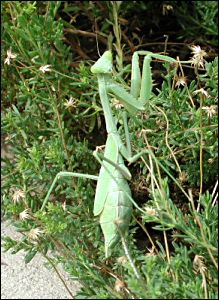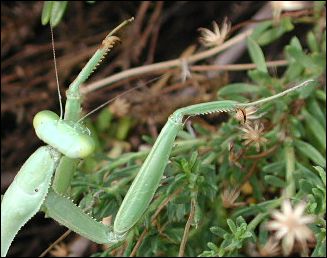
Have you ever seen a praying mantis? Look carefully, because they can blend in well in all kinds of environments, and this is one thing that helps them survive! Mantises are masters of disguise. Some from Africa even look like flowers. Our native mantises, though, sit very still, looking like leaves or twigs and waiting for a careless insect to come close enough to grab!
But mantises don't feed only on small insects—they'll
also eat each other! And a large mantis might eat something as big as a tree frog or a
nestling bird! Most of them stick to eating insects, though, and they can be a
wonderful addition to your yard, providing natural pest control. If you're really
lucky, you might have a bunch of baby mantises hatch in your yard! If you do, enjoy
watching them, but don't bother them.  After all, they have important work to do, keeping your yard
bug-free!
After all, they have important work to do, keeping your yard
bug-free!
Listen to the Audio (mp3 format) as recorded by KTEP, Public Radio for the Southwest.
Contributor: Kodi R. Jeffery, Centennial Museum, University of Texas at El Paso.
Desert Diary is a joint production of the Centennial Museum and KTEP National Public Radio at the University of Texas at El Paso.


A Praying Mantis, Chihuahuan Desert Gardens, 29 September 2001. Notice the formidable armament of the front legs. Photographs by A.H. Harris.